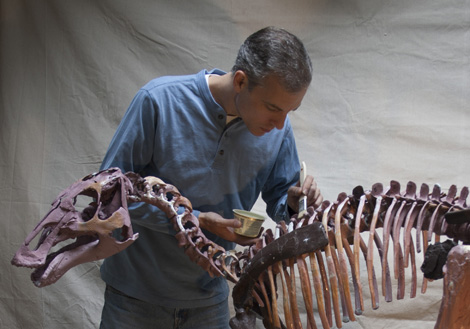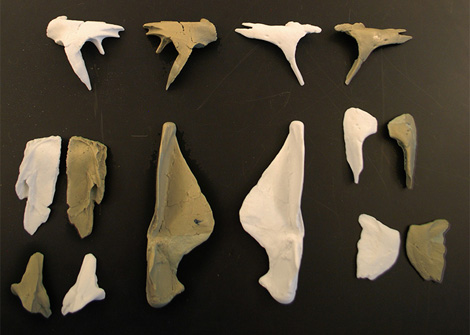
Michael Holland adds the finishing touches to the Ugrunaaluk Kuukpikensis skeleton display
The partial skeleton of newly discovered species of dinosaur Ugrunaaluk Kuukpikensis – in-theory adapted for Arctic living 69m years ago – has been completed and assembled with help from 3D scanning and printing technology.
At Alaska’s Liscomb Bonebed where it was discovered, a three-foot deep layer of prehistoric bones – the richest such bed for dinosaur bones in either polar region – contains thousands of bone samples that need to be managed, sorted by size, but very few have a matching left- and right-sided pair.
To form a completed skeleton the excavation team turned to Bozeman MT, which specialises in creating and building natural history exhibit features.

Plaster casts of the fossilised bones were scanned, reversed and 3D printed to form a full let- and right-sided skeleton
“We could have estimated or been creative about what the skull looked like, but we would have had serious asymmetry and distortion if we did that,” said Bozeman MT principal Michael Holland. “The scientific approach was to take complete fossils in a 3D scan and be able to mirror and accurately replicate them. We could only do that with 3D scanning and 3D printing.”
With the assistance of Peak Solutions, a 3D scanning and printing service bureau, the team took the best sample fossils and created plaster casts and then scanned them using a 3D Systems Geomagic Capture 3D scanner and processed the scan data within Geomagic Wrap.
“The scan data was taken in a minute or two, processed in Geomagic Wrap and mirrored in another few minutes and then it was ready to 3D print in the 3D Systems ProJet 660,” said Ian Sayers, Peak Solutions.
“No need for guessing, interpolating – the end result was an exact but mirrored copy of each fossil to make the skeleton complete.”
With the matched bone parts, Holland built a full skeleton of the duck-billed dinosaur using both the plaster casts and the gypsum 3D printed bones. Some nails and a lick of paint saw the skeleton construction completed in record time.
The project’s lead, Dr. Pat Druckenmiller, associate professor of geology, at the University of Alaska Fairbanks, was impressed with the results.
“This is a very cool and real example of how using new types of 3D digital scanning and printing is revolutionizing what we do in our profession – not just for display but for research overall,” said Dr Druckenmiller. “As a result we are able to reconstruct a new species of dinosaur for the exhibit – in pretty much record time.”






